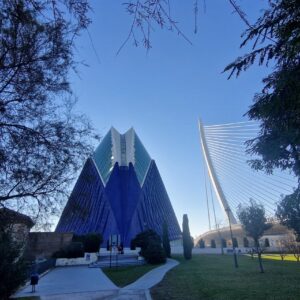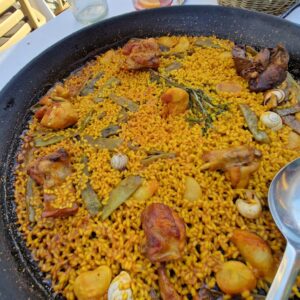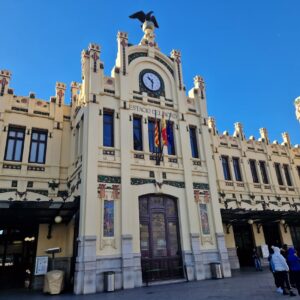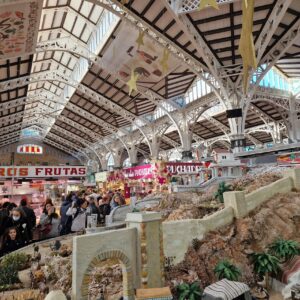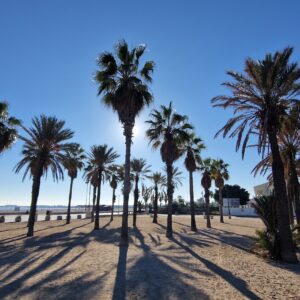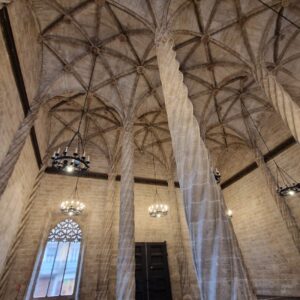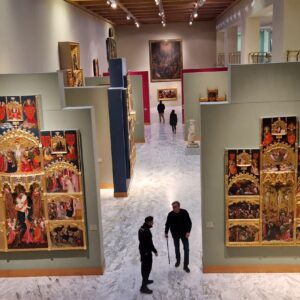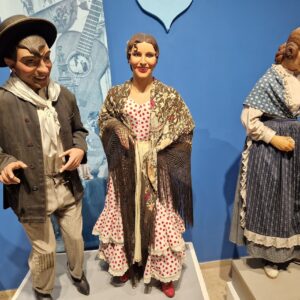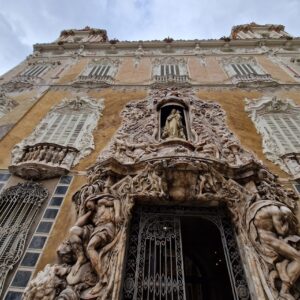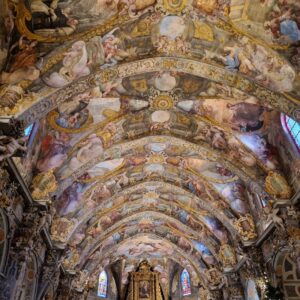Travelogue
By Robert Čoban
In the decades that followed, Valencia turned the catastrophic flood of 1957, when 81 of its residents died, into an opportunity for the city’s complete transformation, which today, according to many surveys, is one of the most beautiful places to live in Europe
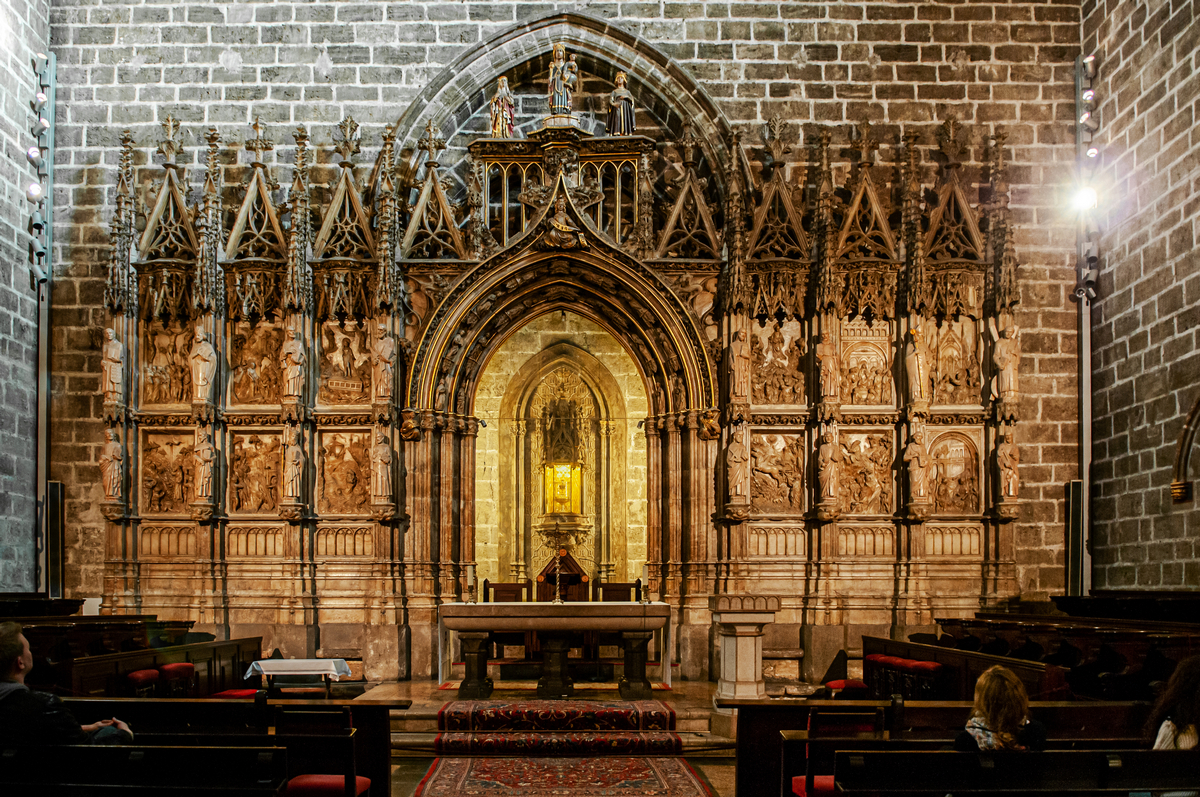
Huge bonfires were burning in the squares of Valencia when we were there in March 2012. We are talking, of course, about the famous Fallas festival, which traces its roots back to the Middle Ages. At that time, near the end of winter, on March 19, on the feast of St. Joseph, local artisans brought their unsold handicrafts and generated waste to the nearest squares and burned them as a sign of welcoming spring. In the 20th century, year-on-year, the aesthetic and artisanal effigies that burn in the squares became more and more perfect so today you just feel sorry when you look at them because you know that all that beauty will disappear in flames on St. Joseph’s Night.
A decade later, an Air Serbia’s direct flight from Belgrade brought us back to this magical city, which in 11 years, has become visibly wealthier, more orderly and embellished.
No country in Europe has learned like Spain how to incorporate nature, historical heritage and modern design into the excellent quality of city life
“This is due, in large part, to the port where a large quantity of the cocaine comes from Latin America to Europe. It is no coincidence that Luka Bojović was arrested there in February 2012. In the 21st century, Valencia flourished because of that drug money, a lot of new buildings were built and huge amounts of money ended up in the city’s budget. It’s just that, unlike us, they know how to reconcile public and private, so everything looks as it should in the end”, a friend of mine who has an apartment in Valencia told me while we were sipping on wine in a restaurant near Palilula outdoor market.
So we arrived on a morning flight from Belgrade and after a half-hour taxi ride from the airport, we checked into a hotel on the beach. As it was still morning, Sandra and the children went to bed to catch up on some sleep and I, of course, rented a bike and set off along the long coastal promenade. The sun and sand can deceive us continentals, so the next morning, I tried to swim in the sea and got out soon after because the water was terrifyingly icy, so much so that I remembered a dialogue from the movie “Titanic”.
After the paella washed down with a bottle of rioja wine, we headed towards the city centre, which you can reach by an easy one-hour walk along the dry bed of the Turia River.
After the catastrophic flood of 1957, when the Turia overflowed, covering two-thirds of Valencia and killing 81 residents, the city heads decided to move the course of the river to the western suburbs and in its old bed, create a spectacular park with both old and new bridges, and which has been constantly upgraded since then. It has cycling and jogging routes, fountains, magnificent museums and palaces, designed by Santiago Calatrava, outdoor children’s playgrounds, botanical gardens and dozens of other facilities. As we walk between spectacular buildings designed by Calatrava, I think that no country in Europe has learned like Spain how to incorporate nature, historical heritage and modern design into the excellent quality of city life. We can really learn a lot from them, so I often recommend Balkan politicians to go to Valencia, Barcelona, Seville or Bilbao to see how the Spanish organize their cities, apart from frequenting restaurants, stadiums and shops.
As we approach Calatrava’s L’Agora, the 1960 film “Time Machine” springs to mind. The Christmas market, located under the arches of the City of Arts and Sciences, looks somewhat surreal in that environment at 18 degrees Celsius.
After the catastrophic flood of 1957, when the Turia overflowed, covering two-thirds of Valencia and killing 81 residents, the city heads decided to move the course of the river to the western suburbs and in its old bed, create a spectacular park with both old and new bridges, and which has been constantly upgraded since then
We arrive in the city centre where many streets are closed off, even for pedestrians, because it is January 5th and the procession is expected to start in honour of the Three Kings holiday. On the Queen’s Square (Placa de la Reina) where the Cathedral is also located, we sit in the outdoor area one of the cafes where we are supposed to meet Michel Saint-Lot and his wife Katia. Michel, a native of Haiti, was the director of UNICEF in Belgrade until four years ago, after which he went to Madagascar and retired in a house with a swimming pool in Provence. Michel and Katia, who also spent the New Year’s holidays here, advise us where to try the best churros, a local speciality, a pastry similar to thin tulumbas that are dipped in melted chocolate. We often get up from the table to see the Three Kings procession, and Katia advises me to put a backpack on my back every time: “Valencia is not like Barcelona, there are fewer street thefts – but you still have to be careful, especially on days like this!”
The morning after, I arrive at the city’s central train station – Estación del Norte (North Station). While the rest of Europe was bleeding in the fourth year of the Great War, in 1917, in neutral Spain, the lavish Estación del Norte railway station opened in Valencia on the site of an old station building from 1852. The god of war came 20 years later here when, in 1937, during the Spanish Civil War, the station was bombed from the air. It is located in the very centre of the city and 15 million passengers pass through it annually.
Not far from the station is the Mercado Central, the main market in Valencia, which construction began in 1914 and was completed in 1928. This is one of the largest covered markets in Europe, spanning as much as 8,000 square metres. During the Christmas holidays, the centre of this space was dominated by a model of the biblical Bethlehem, the place where Jesus was born, and the aromas, colours and tastes of this region spread in all directions – fruits, vegetables, fish, hams, cheese and oriental sweets left behind (just like the hammams) from the time of Moorish rule over the peninsula.
Palacio del Marqués de Dos Aguas, which today houses the National Museum of Ceramics and Decorative Arts, is one of the most lavishly decorated buildings in Spain, perhaps in the world
In Queen’s Square, a large tyrannosaurus doll is moving about, while in front of it is a container for inserting coins. We stare at it, trying to figure out if there is a man inside or if it is a machine. A man “managing the figure” arrives, pushes a large bottle of Coca-Cola and a sandwich into the T-rex through the opening on the back and says – “There’s a man inside!” – in fluent Serbian while laughing. I ask him where he is from: “Romania, Timisoara, we’re neighbours!” After Romania joined the EU in 2007, hundreds of thousands of Romanians came to Spain, as Spanish (one of the Romance languages, just like theirs) was easier for them to learn than German, for instance. “If they hadn’t come, factories like Porcelanosa could have closed because they would have become uncompetitive against Chinese and Turkish ceramic manufacturers. They are willing to work for 700 euros a month, while the Spaniards would never do that”, a representative of the Porcelanosa brand in Serbia told me this in 2012.
Many believe that the Holy Grail, the jar that Jesus used during the Last Supper, is located in one of the chapels of the Cathedral in Valencia (Iglesia Catedral-Basílica Metropolitana de la Asunción de Nuestra Señora de Valencia). A 1st-century jar with Arabic cathedral inscriptions was donated in 1436 by the Spanish king Alfonso V of Aragon. The cathedral was built in 1262 and was extended in the following centuries.
Next to the Cathedral, there is a group of tourists gathered around a guide pulling a map branded with the words “Indiana Tours”. Apparently, Spielberg’s film is the first thing most tourists think of when the biblical Holy Grail is mentioned.
In the Museum of Fine Arts, on the other side of the Turia’s dry bed, we saw a painting of General Francisco Franco, a sight rarely seen in modern Spain. I saw a work of art depicting him only once more and that was in the Legion Museum in Ceuta, the Spanish exclave on the African soil from which Franco went to the Spanish civil war. We also saw an El Greco, a Hieronymus Bosch, a lot of altars and other masterpieces of Spanish medieval art. Entrance to the museum is free.
When you come to a city like Valencia, all your friends who have been there or lived in it will overwhelm you with recommendations for a good place to have lunch. By the way, we like restaurants with street seats that we stumble upon by chance, guided by Sartre’s quote “When you come to a city for a few days, don’t rush to see everything, but find the best bar and let the city pass before you!”. However, this time around, we acted upon recommendations. One of them was the legendary “La Pepica” which was opened back in 1898 on the beach in Valencia and is located right next to our hotel Neptune. This famous restaurant was founded in the late 19th century by Francisco Balaguer Aranda and his wife Josefa Marquis Sánchis, and it was initially just a kiosk selling sandwiches and beer to port workers. King Alfonso XIII granted licenses to Francisco and 44 other restaurateurs to erect wooden shacks on the beach in which to serve food and drink to swimmers. The couple had eight children, and today their grandchildren and great-grandchildren run the restaurant where you can find pictures of numerous famous guests hanging on the walls. From Spain’s King Philip to our own Pedja Mijatović, who played in Valencia from 1993 to 1996. Mijatović often comes here because the family that adopted his sick son Andrej, who died in 2009 at the age of 15, lived there.
If, while in Valencia, you crave the Swiss speciality fondue with cheese (in our case, we are always craving it), “La Fondue” is the best place to be. The restaurant is excellent and inexpensive, but there are not many tables, so you have to reserve your seat up to several days in advance. We were served by a young blonde waiter who was obviously not Spanish. He came here in March, as part of the first wave of refugees from Ukraine when it was still possible to leave the country. We are chatting about Manu Chao’s song “Clandestino”, which talks about refugees – those who left Spain, from the direction of Ceuta, for Latin Americans and who swam across the Rio Grande to reach “the land of the free and the home of the brave”. From the moment when the song was written (1998), many other peoples were forced into exile due to the war – Ukrainians being the latest.
I also visit the Valencia History Museum, which is a little further from the city centre. In the not-overly-impressive collection, I am drawn to the compilation of newsreels, covering the period from the early 20th century to the end of Franco’s reign, which describe events in the city such as the Regional Exhibition in 1909, during which some of the most beautiful buildings were erected, including the famous Bridge of Exposición Regional Valenciana. During the infamous flood of 1957, the river Turia wiped the bridge off the face of the earth. King Alfonso XIII, who ruled Spain for 45 years, i.e. from his birth in 1886 until the proclamation of the Second Spanish Republic in 1931, is on one of the recordings depicting his visit to the Exhibition. Alfonso XIII is the grandfather of the former king, the controversial Juan Carlos, and the great-grandfather of King Philip VI, the current ruler of Spain.
The newsreels also show see scenes from the Second Spanish Republic (1931-1939) and the Spanish Civil War (1936-1939), during which planes from Mussolini’s Italy and Hitler’s Germany bombed the city 442 times, leaving behind 3,831 dead and 847 wounded. After Franco’s victory in the war in 1939, Spain, including Valencia, was bypassed by the Second World War and the city’s recovery began, only to be interrupted by the catastrophic flood in 1957, after which the period of progress begins again, which, with a greater or lesser pace, continues to this day.
Since we were in Valencia on Orthodox Christmas on January 7, I decided to check if there was a Russian church in the city and I found it in a small place not far from the city centre. Christmas service in the Russian Church of St. George was held at 6:00 p.m., and in the temple, I found priest Sergei and a dozen believers, mostly elderly women. It was somewhat shocking to see that the Russians, despised in most of Europe because of the war in Ukraine, seem to celebrate their Christmas almost in secret, like the first Christians.
The next morning, I visited the Museo Fallero de Valencia, dedicated to the Fallas Festival from the beginning of this travelogue. Namely, every year, a special jury chooses the most beautiful effigy to be “rescued” and then exhibited in the museum. There are also posters for Fallas from 1930 to the present day. There was an interesting poster from 1936. Four months after the Fallas Festival took place that year, the Civil War broke out and real fires were burning in the streets of Valencia and other Spanish cities.
A decade later, an Air Serbia’s direct flight from Belgrade brought us back to this magical city, which in 11 years, has become visibly wealthier, more orderly and embellished
I continued cycling towards the centre and as I passed the cathedral I heard the sound of trumpets. I entered the cathedral and I saw young men and women, dressed in traditional Spanish costumes, offering the priest gifts in the form of flower arrangements accompanied by pop music from a brass band. Another of the many testimonies about how much the Spaniards hold on to their tradition and show it at every step.
La Lonja de la Seda (the Silk Exchange) is a Gothic building opposite the Main Market in Valencia. It was built in the late 15th century and during the Civil War (1936-1939), it hosted sessions of the Parliament of the Spanish Republic as well as the Anti-Fascist Exhibition. It has been declared a UNESCO World Heritage Site and looks absolutely spectacular with high arches held up by thin “twisted” stone pillars.
The evening flight to Belgrade gave us a whole day before we depart to see the remaining sights of Valencia. I still have to see the Church of St. Nicholas (San Nicolás de Bari and San Pedro Mártir), which is considered one of the most beautifully decorated temples in the world. It was built in the 13th century and Juan Pérez Castiel completed the decoration of its interior in the Baroque style in 1693. You can sit for hours there and observe the splendour of its ceiling in amazement.
Finally, I left one more building, which beauty you can admire for hours, for the next time – Palacio del Marqués de Dos Aguas, which today houses the National Museum of Ceramics and Decorative Arts, is one of the most lavishly decorated buildings in Spain, perhaps in the world. The palace is said to have been built on a Roman cemetery and changed owners over the centuries until today when it is owned by the Spanish state.
The current look of the Rococo-style facade is from 1745. It is described as “La Gran Belleza”, the Spanish translation of the famous Italian phrase or “Beauty to Die For”, in English. And many did, indeed, die for its beauty!
